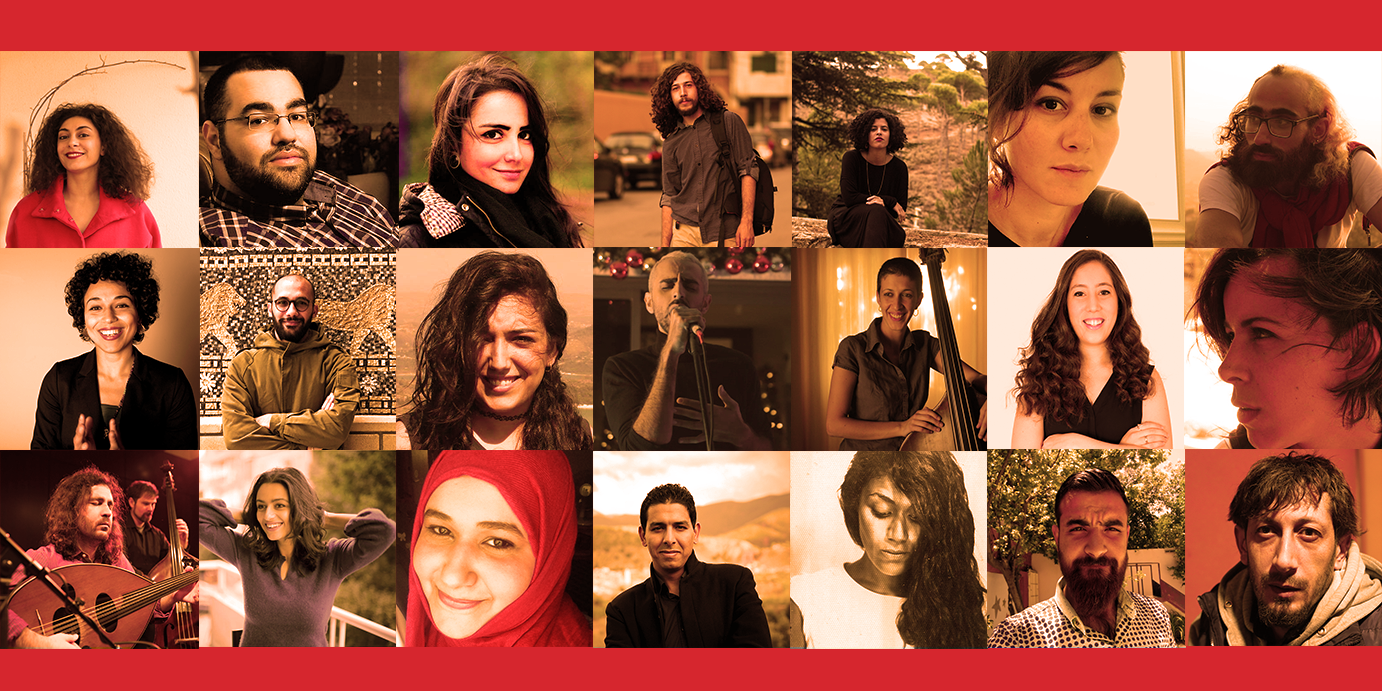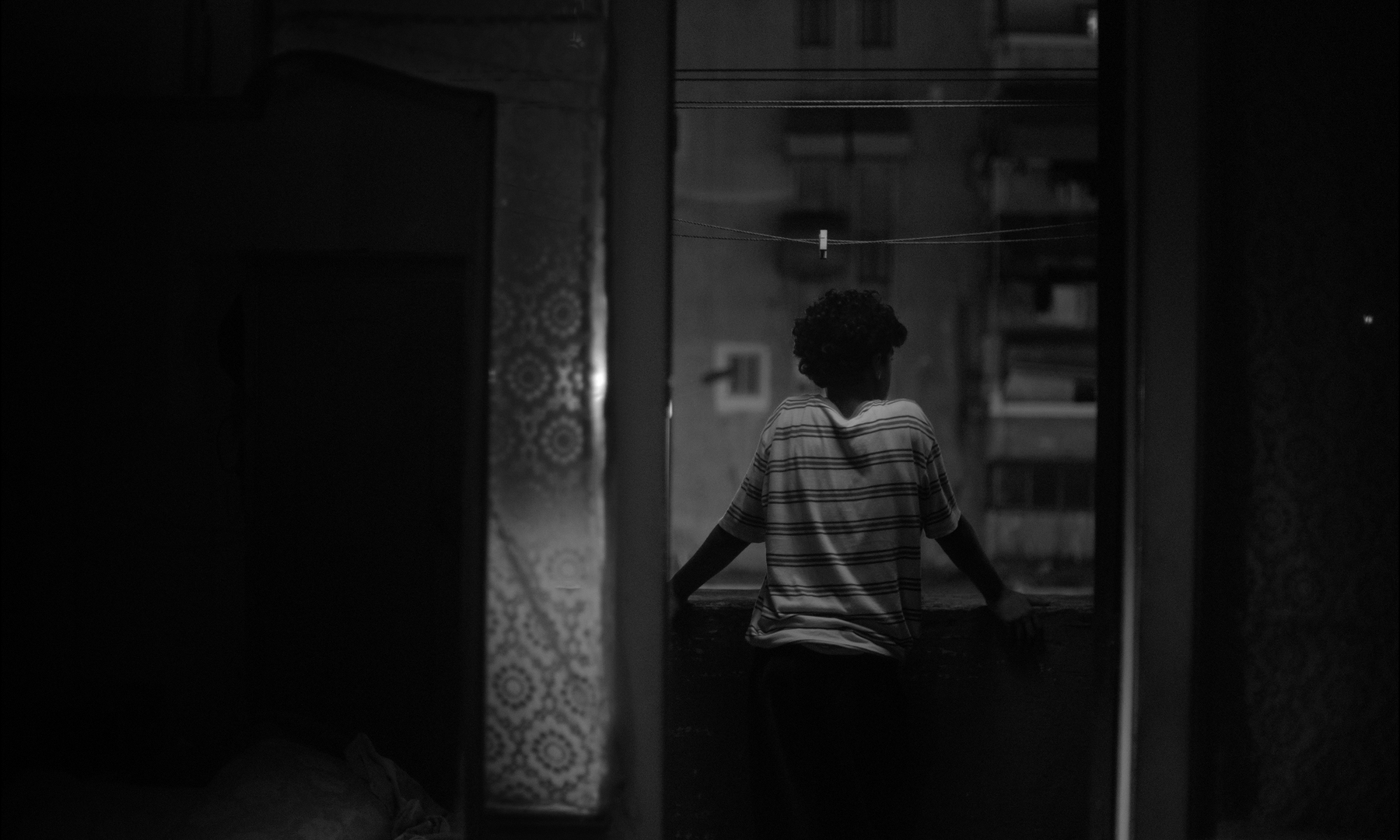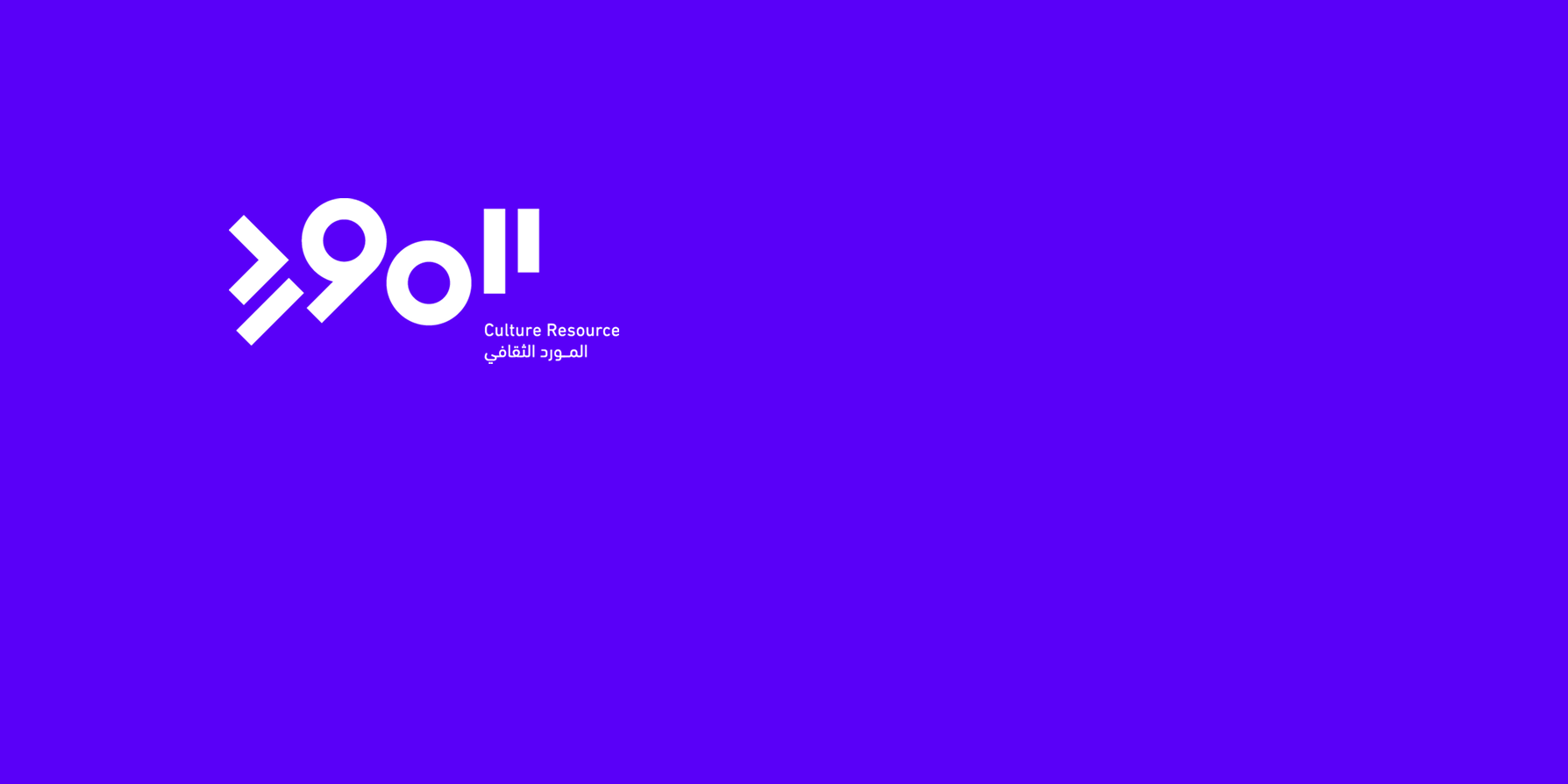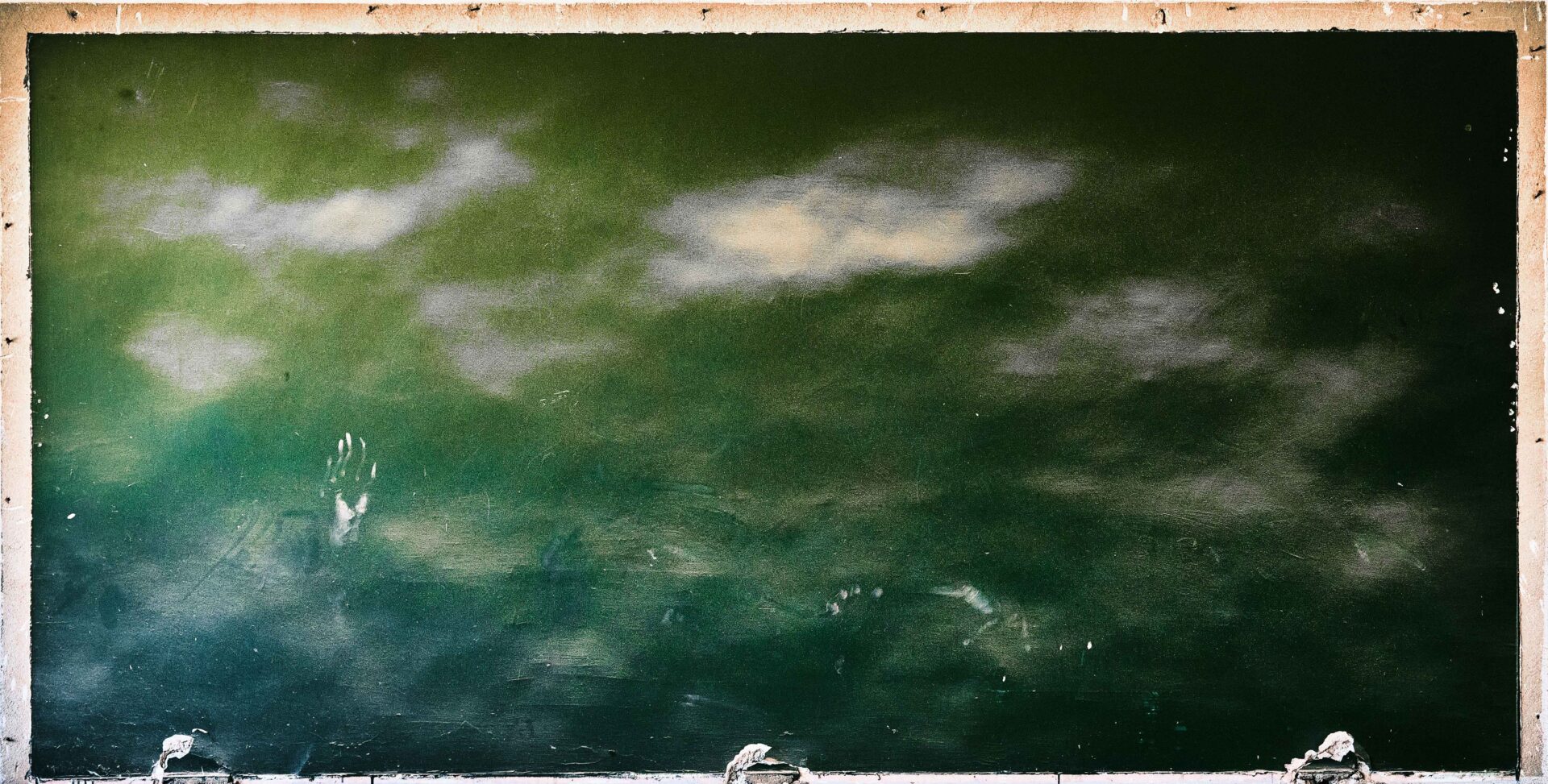28 February 2018
Al Mawred is pleased to announce the grantees in the 2018 round of the Production Awards Program which aims to promote and encourage a new generation of Arab artists and writers through support for their projects in literature, music, theater, visual arts and cinema.
The juries chose 21 projects out of 234 applications that Al Mawred received.
Below are the members of the juries and the grantees of Production Awards 2018:
Theater
The jury gathered theater director and founder of D-CAF festival and Studio Emad Eddin Ahmed El Attar from Egypt, theater director and artist Tania El Khoury from Lebanon, and contemporary dancer, trainer and choreographer Nawel Skandrani from Tunisia.
Remi Sarmini, Syria
“First Class”
The play opens with three passengers waiting in the transit lounge of “An Airport of the World”. They are compelled to travel to a country called “Cities of the World”. Audience members become part of the theme of waiting, the moment they enter the theater, which is transformed into a transit lounge in “An Airport of the World”. They, too, wait for their flight until the performance ends with the announcement by an airport official that the flight has been delayed. The work depends as much on gestures and body movement as it does on dialogue to express the ideas of waiting and anticipation – perhaps for salvation.
Farah Saleh, Palestine
“Gesturing Refugees”
A contemporary dance performance with interactive video that examines the role of the artist in creating change by using the body as an archive in the process of discovering and exploring collective memory and political narrative. The performance will archive some of the movements and gestures that exist in alternative stories of refugeehood that have been omitted from the official archive. Refugee artists from Palestine and Syria will come together from the different parts of the world in order to collaborate in the re-enactment, interpretation and contextualization of gestures and other physical movements related to the refugee experience.
Petra Serhal, Lebanon
“Toyota 89”
A sensorial live performance that explores the physical and political fragmentation in places such as Beirut, and questions the practice of choreography in this particular context.
Sari Mustafa, Syria
“Injection / The Game”
An experimental / reality theater performance that addresses the themes of love, giving, self-sacrifice, betrayal and loss. Karam, husband and lawyer (48), Abeer, wife and doctor (38) and Bahaa, young actor and lover (27) become entangled in a game, devised by the husband after he becomes maimed and sexually impotent as the result of injuries sustained by the detonation of a mortar bomb that also killed his son. The game places the wife/doctor and lover/actor on trial but the disclosures and unearthed evidence soon expose a conspiracy by the wife and her lover against the shattered husband, a victim of successive losses.
Visual Arts
The jury gathered visual artists Khaled Hourani from Palestine, Huda Lutfi from Egypt and Yasser Safi from Syria.
Noor Abu Arafeh, Palestine
“Paintings that didn’t find their way back”
An exhibition dealing with the representation of history and, specifically the history of art and artistic institutions as relates to Palestine. In this unique artistic endeavor, the artist investigates two historical exhibitions of works by Palestinian artists that took place in Switzerland, but the artworks never returned and their fate still remains a mystery. The project examines how it is possible to write about and document a historical event when the documentary sources are missing. Shifting between an academic and an artistic approach, the artist attempts to forge a historical account of an unrecorded art history (the loss wasn’t recorded, although it is the most important thing to be recorded), following an oral narrative that generally straddles the boundary between truth and fiction. The project will culminate in the production of a video installation and booklet that will be displayed together with other works by the artist in this one-person exhibition that will take place in Jerusalem and Cairo. Lara Khaldi will curate the exhibit in both cities.
Wiame Haddad, Tunisia
“In Absentia”
The project is to trace the allegedly absent visual archive of the period of political struggle and state repression in the post-independence era in Morocco in order to create an “iconology” for that period. Bringing together artists, researchers, former and current political activists and opposition members, it will attempt to find a realm of convergence between historical research, personal narratives and artistic research focused on the years of left wing radicalism, underground activity, prison and exile for Marxist-Leninist oriented political activists in the 1970s. The “visual archeology” will consist of paintings/collages incorporating different types of documents, family and personal archives, and installations and photography by Wiame Haddad. Questionnaires, historical texts, literary excerpts, types of documentation or merely an explanatory label will accompany each composition. “In Absentia” proposes a modern and regenerative approach to the history of political commitment (especially among Marxist-Leninist movements) and state repression in the 1970s in Morocco through the ostensibly missing images and visual archives from that era.
Salma Bakr, Egypt
“Two Photos and a Stamped Application”
The project is inspired by Laila Soliman’s performance, Zigzig, which draws on historical archives in its treatment of a British military tribunal that was created in order to investigate the claims of women from the Egyptian village of Nazlat El-Shobak that they were raped by British soldiers during a violent raid of that village by British occupation forces in 1919. The performance plays on testimony furnished by the women, but delivered in English, since it was impossible to obtain local Arabic sources on the incident. The only available documentation was the court transcripts written by British army officials at the time and accessible to the public in the British Foreign Service archives. Salma’s research is also based on anthropologist Ann Stoler’s call to write the contemporary history of Egypt “against the official grain”. Rarely do historians in Egypt speak of the circuitous paths they need to pursue in order to be able to study their own history through archival material even though such material is a fundamental part of the history they want to write about, and this is what Salma will be treating in her short experimental video.
Marwa Benhalim, Libya
“The Chair”
A long term multimedia (written text, video, sculpture and performance) project, “The Chair” investigates symbolic domination in the Arab region through the concept of the “seat of power”. Power in the Arab region is embodied in “the chair”, from the throne occupied by the dictator when addressing the nation to the coffeehouse chair. This ubiquitous article of furniture and one’s proximity to it throws into relief the reciprocal relationship between the individual and power.
Cinema
The jury gathered the cineaste Ossama Mohammed from Syria, the founder of Sudan Independent Film Festival (SIFF) Talal Afifi from Sudan and poet, scriptwriter and film director Nujoom Al Ghanem from UAE.
Shaza Moharam, Egypt
“Mnemosyne”
Shaza returns to her hometown, Alexandria (Egypt), in a quest for memory. Following the death of her grandfather, she realizes that she suffers from a severely deficient autobiographical memory (SDAM): she knows the stories from the past but does not remember having lived them. She uses the camera as a tool to trigger memories, by recreating past events in familiar Alexandrian spaces. In the process, she discovers that the city, itself, has lost its memory, and her personal struggle confronts the plight of a collective urban memory that has evaporated into oblivion. “Mnemosyne” blurs the boundaries between media, disciplines and concepts: documentary and fiction film, science and myth, film and visual art, and the individual and the collective memory.
Areen Al-Asmi, Syria
“Ripped Soul” (working title)
The filmmaker’s journey of self-discovery as she films the stages of her journey in the big city, Damascus, in search of answers to questions for which wartime left no space. The three female characters in the film portray the city, the impact of the war on it and, indirectly, the relationship between the characters and their origins and, by extension, the nature of their prospective relationships with their land after the war ends. Areen eventually discovers that the answers she is looking for cannot be found through those persons but, rather, by delving into roots in her native village in the south, which sets into motion the return journey to the self.
Sarah Francis, Lebanon
“Swings” (working title)
At night, in an open playground, family members gather to discuss the state of their family life. We are unsure whether what they tell each other is true but they have the freedom to invent stories, cast blame, express gratitude and pose questions. The space becomes a material playground for their ideas. None of the characters in the film speaks on camera; their voices are always off-screen as though coming from another time or place. The characters come and go, rise and fall on swings or turn back and forth in circles, and through such repeated two-part actions they lead us to voices from other places: voices of conversations elsewhere or their internal voices. The film quickly transports us beyond its physical playground setting to the imaginary terrains created by the voices. At one point a voice might bring us back to the family home; at another it might lead us to other spaces, spiriting us from the private to the public realm in a flash. The result is an hour of playfulness which evolves into a form of choreography that allows us to discover how the characters interact and offers us access to the virtual spaces that form the focus of their lives.
El-Baqer Jaafar, Iraq
“Take Me to the Cinema”
A fictional documentary that focuses on two ex-soldiers and their relationship to the cinema. The fictional portion portrays how one of the soldiers escaped for 5 days during the Iraq-Iran war. The events are related through the eye of the director, the filmmaker who had never gone to a cinema theater in his childhood. The film opens with El-Baqer reproaching his uncle who had never taken him to the movies when he was a child. The only cinematic journey that El-Baqer recalls is the last time his Uncle Daoud went to the movies. Then warfare began to take such a heavy toll on Iraqi society that people stopped going to the cinema, preferring instead to save their money for basic necessities. As El-Baqer, in the film, attempts to discover what caused cinema theaters to disappear in Baghdad, he becomes involved in the escape of a former Iraqi soldier.
Jumaa Al-Marzouk, Syria
“Damascus Doesn’t Rain Jasmine”
A short documentary film that relates the story of a man, his wife and four children in their home which, like all others in the town of Douma, was not spared from the bombings since the beginning of the uprising in 2011. The man acquired a reputation as the “neighborhood madman” because of his hobby of collecting missile shells. From these empty shells, he began to create works of art and toys for children, and eventually a local amusement park. He became a manufacturer of happiness. Abu Ali, as the man is called, originally got the inspiration from a child he came across, one day, sitting on a still undetonated missile. The idea evolved into a project for turning the missiles of certain death sent from the “Jasmine capital”, Damascus, into a source of hope to sustain the children and families of the besieged town of Douma.
Literature
The jury gathered novelist and journalist Hassan Daoud from Lebanon, novelist and short story writer Hammour Ziada from Sudan and poet, writer and journalist Nouara Lahrache from Algeria.
Tariq Bakari, Morocco
“Dimi, the Moon Child”
“Yanja” is the child of an illicit relationship between a slave-owner and a woman from a tribe in southern Mauritania following the French occupation. To the slaves “Yanja” is a master while to the masters he is a slave. He struggles to win the heart of “Dimi”, the daughter of a Sufi sheikh and a “moon child”. His courtship would soon be brought to an end by his enslavement, castration and shipment to three areas that were victims of French colonial tyranny (Mauritania, Morocco and Senegal). In the course of these journeys, the story moves beyond how oppressed peoples view the colonizer to an investigation of how the European collective imagination perceives these peoples.
Ali Mawassi, Palestine
“In the Land of Madiba”
An illustrated poetry anthology that combines poetry with photography in an attempt to identify and produce the emotive powers they have in common. In this literary/visual project, photography will complement the text but will remain independent from it at the same time. The core idea is to follow people’s struggles in a society after liberation through their stories, their concerns and aspirations; through the sounds, flavors, colors and smells of their daily lives; and through the meeting between word and image, making it possible for the text to reach new and unfamiliar places and opening windows to view the world from different angles.
Somaya Abdul Kader, Yemen
“Seven Women and a Half”
A novel that relates the stories of seven women and a female child who have to contend with the hardships and agonies of war. They are of different ages, backgrounds, parts of the country and circumstances. Even the nature of their personal tragedies vary. But they share the fact that women’s suffering in Yemen has long been something hidden and not to be spoken of. Then the war broke out and these women’s pains and sorrows erupted into the open as their loved ones were claimed by the grave, the prison, the rubble and all the destruction that consumed people’s homes, children and dreams. As a Yemeni writer, Somaya believes that such pains should not be forgotten and, therefore, that they should be immortalized in writing.
Juan Titr, Syria
“The Book of Things”
A biography of the war in Syria through prose: a series of testimonials to “things” related to the day-to-day life of the author during the war in an area in which the fight against extremist organizations and daily bombings left indelible marks on urban objects. Not only do streets and buildings change from a concrete perspective, everything changes from an intellectual and psychological perspective. During the years that the author lived under the conditions of war, he found that the most familiar details of life and the most ordinary daily routines, including the business of evacuating bowels, shift and metamorphose from one day to the next. Such changes become the material for his definitions of things. Love changes under the circumstances of war, children change, contradictions and ironies emerge. All such things will be examined and explained under an expressionist and illustrative lens that seeks to pin down the meaning of things during war.
Music
The jury gathered the cultural activist and music professional Brahim El Mazned from Morocco, the violinist and composer Jasser Haj Youssef from Tunisia, and the poet, writer and music critic Fadi El Abdallah from Lebanon.
Donna Khalifeh, Lebanon
“Amal” (Hope)
Fighting pessimism has become a necessity in today’s world. Donna Khalife’s second album is a tribute to hope, that ever-present, undemanding internal force that helps us face life’s ups and downs. This project is Donna’s simple contribution to an eternal human feeling, with the collaboration of various poets and musicians.
Kenan Adnawi, Syria
“Journey with the Oud” (working title)
A musical album featuring musical compositions of the oud mainly accompanied by other musical instruments including cello, Qanoun, contrabass, rhythm and violin, with the participation of guest musicians, and will include a number of recent compositions by the artist.
Rama Nasri, Syria
“Zaghareed Suriyya” (Wedding Songs from the Syrian Heritage)
The Gardenia Choir collects Syrian music and songs related to the wedding ceremonies of different cultures, ethnic communities and regions in Syria. It has compiled and arranged 14 pieces of such folk music and the choir will perform them, in March 2018, at the Damascus Opera House and in Beryte theater at USJ university in Beirut. The Gardenia Choir will attempt to preserve this heritage by recording it in Damascus, distributing the musical material to cultural centers and national theaters in Syria, and disseminating it across social networking sites and on the Gardenia Choir’s YouTube channel, thereby making it as widely available as possible.
Bashar Murad, Palestine
“Shilet Hamal” (Bunch of Bums)
The project is to produce a song and accompanying video clip inspired by all individuals who chose unconventional paths for their careers, and seeking creativity and innovation, the expression of new ideas for people without a voice, and the creation of a relatively unique space for disseminating humanitarian values such as faith in people’s autonomous capacities, the right to differ constructively, the freedom of expression that respects the freedom of others, and the ability to follow one’s dreams.
* We would like to remind you that this round is the only round for year 2018. The call for application for round 2019 will be announced in the 2nd half of the current year.





